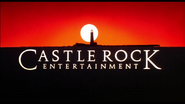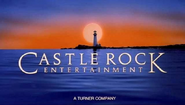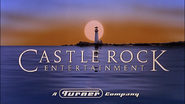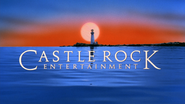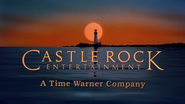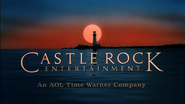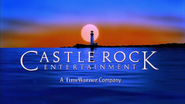Background[]
Castle Rock Entertainment was founded in 1987 by Martin Shafer, actor and director Rob Reiner, Andy Scheinman, Glenn Padnick and Alan Horn, with Columbia Pictures as their original strategic partner. Early in the studio's history, Nelson Entertainment co-financed their films until 1991, when New Line Cinema took over their duties (after Nelson was sold to New Line). On Christmas Day 1993, Castle Rock was acquired by Turner Broadcasting Systemand would become a part of Time Warner when the two along with New Line Cinema merged with them on October 10, 1996. In 1999, Warner Bros. Pictures gained distribution rights from Sony Pictures Entertainment/Columbia Pictures. Castle Rock's first release was Winter People in 1989, but no logo was used until When Harry Met Sally.... The Castle Rock production label was a subsidiary of Warner Bros. Entertainment., until numerous box office failures caused the folding of the label in 2010, with the last film officially released by the studio being Did You Hear About the Morgans?. Starting with the Reiner-directed film Flipped in August 2010, several movies produced afterwards would use the Castle Rock name with special permission, specifically movies made by Rob Reiner himself (i.e. LBJ).
The home media rights to the pre-1994 Castle Rock library (which was part of Nelson's library) were sold to Epic Productions, which incorporated it into its Gamma library, and then to PolyGram Filmed Entertainment; Metro-Goldwyn-Mayer acquired these rights in January 1999 after purchasing the pre-March 31, 1996 PolyGram library (including their back library) (exceptions are A Few Good Men, In the Line of Fire, and North, co-productions with Columbia Pictures that remained with the studio and The Spirit of '76, which Castle Rock produced and has a copyright holder alongside Black Diamond Productions, owned by Warner Bros.). Warner Bros. Television does own the television rights to most Castle Rock films. The post-1994 library is owned by Warner Bros. (except for distribution rights of The Story of Us, The Last Days of Disco, and international rights to The American President, all of which are owned by Universal Studios, the original distributor). Castle Rock retains the copyright to nearly all of its films.
1st Logo (July 14, 1989-July 29, 1994)[]
Nicknames: "The Lighthouse", "The Light Tower", "Majestic Lighthouse" , "The Lighthouse At Sunset"
Logo: We see a white light on a black background rotating counterclockwise, then the background fades to reveal some land and a lighthouse at sunset. An orange sun rises up from the bottom of the range, and the light reveals the plain white words "CASTLE ROCK ENTERTAINMENT" at the bottom of the screen. The sun becomes white, and the light disappears when the logo is finished.
Trivia:
- Rob Reiner once said in an interview that the lighthouse was an allegory of the company's image: allowing creative talents to make their own projects with more freedom than the major Hollywood studios would allow ("safe harbor", as he calls it). Indeed, Castle Rock's nurturing of such talent, including (most notably) Jerry Seinfeld and Larry David, made it one of the most successful production companies of the 1990s.
- The company name comes from the name of the fictional town in Maine that is the setting for several Stephen King stories (which he named after the rocky outcrop named "Castle Rock" in Lord of the Flies. Reiner himself named the company after the town after the success of his film Stand By Me, (which is based on King's novella, The Body).
- It is worth mentioning while this is the first logo used for theatrical releases, Castle Rock debuted its lighthouse logo a year earlier for their television unit in a still logo with morning skies and blue water.
Variant: On several films, right before the light beams past the screen, the company name can be seen in the shadows.
FX/SFX: The sun rising, the "CASTLE ROCK ENTERTAINMENT" text appearing, and the lighthouse shining. All nice 2D animation.
Music/Sounds: A soft piano sounder followed by a five-note fanfare with horns and bells. This tune was composed by Marc Shaiman.
Music/Sounds Variants:
- Some films, such as some prints of Misery, Year of the Comet and Honeymoon in Vegas, have the end part of the theme a bit different.
- On some films, the opening theme is played instead.
Availability: Common.
- It was first seen on When Harry Met Sally... (the second film released by the studio) and ended with Barcelona, though it is believed that original theatrical prints of The Shawshank Redemption contained this logo before the next one debuted.
- Other notable films that used this logo include Lord of the Flies, Sibling Rivalry, Misery, Late for Dinner, Year of the Comet, Honeymoon in Vegas, Mr. Saturday Night, Amos and Andrew, Needful Things, Malice, City Slickers 2: The Legend of Curly's Gold, and Little Big League.
- It is also preserved on the Columbia Pictures-owned A Few Good Men, In the Line of Fire and North.
- It can also be found on the Olive Films Blu-ray release of Sibling Rivalry (alongside the original Columbia logo, all preceded by the 2001 MGM lion).
- On some current prints of films, this is either plastered with the MGM logo on home media releases, such as the DVD releases of City Slickers, Sibling Rivalry, Mr. Saturday Night and Honeymoon in Vegas, or replaced with the next logo on television.
- Some prints of films aired on TNT and TBS have this logo with the original Columbia Pictures logo intact.
- On Starz and Encore airings of City Slickers 2, as well as on the Warner Home Video DVD release, it has the logo intact but is preceded by the 1998 Warner Bros. Pictures logo with the AOL Time Warner byline (since that logo plastered the original Columbia Pictures logo).
- This logo is preserved on Nelson Entertainment and New Line Home Video (distributed by Columbia TriStar Home Video) VHS releases of pre-1994 films. The logo is preserved on VHS releases by MGM/UA Home Video and PolyGram Video (along with possibly early DVD releases by the company).
- Strangely, it appeared on a 1998 airing of The Shawshank Redemption on WIN Television in Australia, preceded by the 1992 Roadshow Television logo, with the transition effect. It's possible that this logo was used on its original 1994 theatrical run and the next logo appeared when it was re-released in early 1995 during the Oscar season.
- Don't expect this to appear on The Spirit of '76; although Castle Rock owns the copyright (alongside Black Diamond Productions), it just has the Commercial Pictures logo.
Editor's Note: Despite the animation being choppy and dated by today's standards, it was great for its time, helped by the nice music from Marc Shaiman.
2nd Logo (September 10, 1994-November 11, 2023)[]
Nicknames: "The Lighthouse II", "CGI Lighthouse", "CGI Light Tower", "CGI Majestic Tower" , "The CGI Lighthouse At Sunset" , "The Lighthouse At Sunset II"
Logo: Same concept as the previous logo, but now in CGI. On a black background, a white light rotates counterclockwise, then the background fades to a blue and orange gradient sky with water to reveal a lighthouse and a house. As we zoom out, the white light turns from left to right while the plain light orange sun rises up and sweeps around to reveal the words "CASTLE ROCK ENTERTAINMENT", in the same font as the previous logo and colored in white, below the lighthouse. The company name now zooms out from the bottom of the screen, with a byline fading in below that. The light disappears after the logo is fully formed.
Bylines: This logo normally has a byline with the name of the parent company at the time:
- September 23, 1994-September 22, 1995: "A TURNER COMPANY" (in a Helvetica font)
- November 17, 1995-August 23, 1996: "A Turner Company" ("Turner" appears as the 1987 Turner Broadcasting logo, and the rest of the text is in the same font as it)
- September 27, 1996-February 14, 1997; November 11, 2023-present: Bylineless
- January 30, 1998-December 22, 2000: "A Time Warner Company" (in Bookman Old Style)
- September 28, 2001-April 30, 2004: "An AOL Time Warner Company" (also in Bookman Old Style)
- July 2, 2004-July 13, 2018: "A TimeWarner Company" ("TimeWarner" appears as the corporate logo; the rest of the text appears in the FF Meta font)
Variants:
- On The Last Days of Disco, the logo fades out early, but the fanfare finishes into the Westerly Films logo.
- On Sleuth, a completely still version of the logo is used.
- On Albert Brooks: Defending My Life, the logo fades out just as the light reaches its end point.
- There is an international version, which appears in closing credits. The logo there is black and white, has "Distributed by" above and INTERNATIONAL below (however, the regular logo has no closing variant).
FX/SFX: The lighthouse and the company name zoom-out, which are all done in CGI that is very ahead of its time.
Music/Sounds: A re-orchestrated version of the previous logo's fanfare (again by Marc Shaiman), that sounds more dramatic and powerful than before. Although the logo debuted in 1994, this rendition of the fanfare would not be used until 1995 on Forget Paris, as the first three films with this logo (The Shawshank Redemption, Before Sunrise and Dolores Claiborne) used their opening themes.
Music/Sounds Variants:
- On some current prints of films that used the previous logo, this plasters it but keeps the original music; examples being Crackle's print of Misery (that also being seen when The Weather Channel aired the movie back in 2009) and the Shout! Factory Blu-ray of Little Big League. The 1989 theme was also used on Beyond Rangoon.
- On And So It Goes, the fanfare was re-arranged to sound more powerful, minus the dings heard at the end.
- Depending on the film, the fanfare may be tweaked slightly, such as a modified reverb effect.
- In other cases, the opening theme of the film is used instead.
Availability: Although certain byline variants vary in availability, the logo is common overall.
- Debuted on The Shawshank Redemption (the earliest theatrical prints likely used the previous logo) and continues to be used in front of movies directed by Rob Reiner.
- The early Turner variant is rare; it appears on the original Columbia TriStar Home Video VHS releases of The Shawshank Redemption, Before Sunrise, Forget Paris, Beyond Rangoon, and The Run of the Country. It was also seen on the Warner Home Video release of The Shawshank Redemption.
- The normal Turner variant is slightly more common and appears on The American President, Dracula: Dead and Loving It, City Hall, Alaska and Striptease.
- The bylineless variant is seen on Extreme Measures, Ghosts of Mississippi, Hamlet (1996), Some Mother's Son, Waiting for Guffman, SubUrbia, and Absolute Power. It also made a reappearance on the 2023 HBO documentary Albert Brooks: Defending My Life on the Max streaming service, and is expected to appear on upcoming films from Rob Reiner.
- It also appeared on the Hamlet game for Windows.
- The first Time Warner byline is seen on Zero Effect, My Giant, The Green Mile, Mickey Blue Eyes, Bait, Best in Show, Proof of Life and Miss Congeniality. It also appeared on the original release of The Last Days of Disco and on the original video releases, but current prints replace it and the Gramercy Pictures logo with the Focus Features logo (even the last part of the logo's fanfare that goes into the credits is muted out). It was also surprisingly restored on the UHD release of The Green Mile, which was previously plastered by the newer byline variant.
- The AOL Time Warner variant is seen on Hearts in Atlantis, The Majestic, The Salton Sea, Two Weeks Notice, The Adventures of Pluto Nash, Murder by Numbers and Kangaroo Jack. Envy also uses this variant, despite all the Time Warner companies using the TimeWarner byline at this point. This is likely because of its delayed release.
- The second TimeWarner byline is seen on almost all 2004-2018 films from the studio from Before Sunset to Shock and Awe, and sometimes plasters the previous and older-bylined logos on newer prints of older films.
- The international version is rare and appeared on some older films worldwide; newer releases sometimes plaster it with either a New Line Cinema or Warner Bros. Pictures logo. It can also be found on the 2000 Warner Home Video NTSC DVD release of Absolute Power. However, this logo does not appear on Friends with Benefits.
Editor's Note: A good upgrade to CGI update of the previous logo with a nice majestic interpretation of the original theme.

